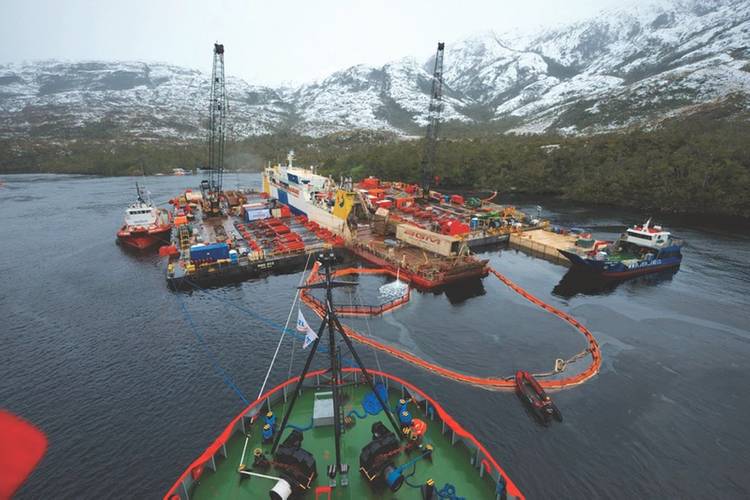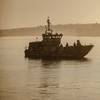Todd Schauer is Director of Operations at Resolve Marine Group, as well as President of the American Salvage Association. After graduating from the U.S. Coast Guard Academy with a degree in Naval Architecture in 1991, he followed that up with graduate degrees in Naval Architecture, Marine Engineering and Mechanical Engineering from the University of Michigan. And, while his considerable U.S. Coast Guard experience includes shipboard engineering, marine safety, advanced engineering and emergency response, he is best known for his longtime role in the commercial salvage business. Schauer possesses more than 25 years of success as a Project Manager, Salvage Master, Naval Architect, and Marine Engineer; including 20 years of salvage related experience, underscored by five years of service on the USCG Salvage Emergency Response Team (SERT), including acting as Team Leader. Todd’s certification and experience as a Registered Professional Engineer and understanding of Naval Architecture principles bring an added value to his ability in directing complex salvage operations. Beyond this, he served for 9 years on active duty with the U.S. Coast Guard including as an Engineer aboard the Polar Class Icebreaker POLAR STAR. Simply put, this salvage and response professional has done it all. Today, he is directly responsible for Resolve’s global salvage, wreck removal and firefighting operations. His most recent major project accomplishments include wreck remediation of the M/V Rena and the Ro/Ro Amadeo 1 wreck removal. The American Salvage Association (ASA) is indeed fortunate to have him at the helm, and Marine News is similarly grateful to have him weigh in on the hottest response topics of the day. Listen in as Todd Schauer schools us on ‘all things salvage.’
Give us an overview of the Salvage Industry in 2017 – the good and the bad – domestically and across the globe. What’s the number one thing on your plate today?
The salvage industry has been plagued by market woes much like other segments of shipping and oil and gas production. The reported global salvage revenue in 2016 was approximately 50 percent of the prior year and early 2017 was not much better – that represents a major tightening of the belt for salvage operators and it takes the fun out of maintaining an expensive salvage response capability. We have seen such cycles before that test the long term commitment of the salvage companies. Underwriters should enjoy it while it lasts because the salvors will not soon forget this period.
As we approach the end of this calendar year, what’s the latest on the LOF – is it dead, coming back, changing? What is its future? If it goes away – what is the impact on the salvage business?
The LOF is certainly not dead. It remains a very common sense contract for emergency response that has stood the test of time and it is still used frequently in cases of peril. However, market pressures and human intervention have led to a watering down effect. The depressed value of ships has a direct negative impact on the potential for LOF salvage awards. Further, cut-throat market practices have led to a practice of LOF side letters between salvors, owners, and underwriters, modifying the terms, capping awards, etc. The beauty of the LOF has always been its simplicity and thus the ability to immediately contract a salvor without rounds of contract negotiation. Unfortunately, all sides are complicit in taking an otherwise perfect contract and modifying it to imperfection on a case by case basis.
What’s the key difference (if any) between how U.S. salvors operate and the way international operators run their businesses? What can one sector learn from the other?
The key difference is that the U.S. market has taken a big step in the direction of pre-arranged, regulated, retainer based contracts for salvage response under the OPA 90 Salvage and Marine Firefighting (SMFF) Regulations. This represents a marked contrast in how salvors operate in the U.S. compared with the rest of the world. In the U.S., the salvor secures the job well in advance of any casualty by contracting as the SMFF provider whereas most everywhere else, the job is won in a more traditional manner on the merits of the salvor’s response capability when and where the casualty occurs. Salvors that can operate and be successful under both systems have the best chance of long term success; however, I believe there will be a steady trend toward more regulated, prearranged salvage contracts including global service agreements in the future.
In 2013, NOAA submitted a report to the U.S. Coast Guard after completing an assessment of known and potentially polluting sunken wrecks in U.S. waters, known as the Remediation of Underwater Legacy Environmental Threats (RULET) project. Has there been any movement on this report on 17 high risk wrecks that were recommended for further assessment and potential oil removal?
I am pleased to report that there is some positive movement on this front. The U.S. Coast Guard has just recently solicited for the assessment of the wreck of the Coimbra off of Long Island for total pollution potential. This wreck has been observed to be leaking oil for some time. There are several other WW2-era coastal wrecks that are also persistent leakers that clearly represent a substantial threat of pollution. We are hopeful that these will be acted on as well.
P&I Clubs are concerned about the rising cost of wreck removal. What should salvors say in response? How can both stakeholders work closer and with more effectiveness?
If you look at market trends over the past couple of years exactly the opposite is true! Salvors are very concerned about the dropping cost of wreck removal and so should the P&I Clubs. The Clubs have taken advantage of the current market that has thoroughly depressed wreck removal prices, but it may well backfire if this forces further consolidation among the salvage majors. The trend of hiring wreck removal contractors, many of which are new in the market, just because they are cheap and will take the most risk is not a good long term business strategy for anyone. The same is true of emergency response contracts. I was involved in tendering for a recent emergency response where underwriters stated up front that they expected a discount of 25 percent on the internationally accepted SCOPIC rates. That is no way to foster a development of salvage capability and meet the rising demands of modern salvage including mega ship response, etc.
Local and regional salvage companies now think they can compete on the world stage. Increasingly, they bid on jobs that typically would have been bid out to 4-5 companies with the financial wherewithal and proven experience to do the job. Now you may have 10 or more companies bidding on work, and it could cost a half a million dollars or more to do the survey, draw up the plans, do the diving and complete the RFP. At the end of the day, only one company gets the work and the others are out a lot of money. How do you balance the need to participate in the bid process with the knowledge that you might not be the “winner” on a given day?
As I stated above, the trend is exceedingly frustrating to the major salvors that have made huge investments over the decades in personnel, equipment and overall capability. Our members don’t mind competition but the tender process must be managed professionally and fairly. All too often underwriters and their chosen representatives ask for professionalism, experience and quality but in the end they succumb to price pressure or hold a risk auction. I am comforted by the belief that time has a way of sorting things out and that we are due for a market correction to the positive for our members.
What is the salvage response (as early as it may be) to Harvey on Gulf Coast?
ASA salvors are busy responding to numerous vessel and waterways issues in the aftermath of Hurricane Harvey. While most of the media focus has rightfully been on the tragic flooding event in the Houston area, the Category 4 hurricane made landfall north of Corpus Christi and the wind and storm surge damage is primarily in that area. ASA members took the lead on channel clearance operations in Port Aransas and Port Mansfield to remove vessel casualties. There are numerous other salvage projects underway in this zone including sunken tugs, stranded barges and many displaced fishing and recreational vessels. Despite the fact that several of our member companies are based in the Houston area and directly affected by the storm, the ASA responders mounted a rapid and effective response. As I write this Hurricane Irma has just strengthened into one of the strongest hurricanes on record and is bearing down on the Caribbean and towards the U.S. Undoubtedly, the aftermath of this storm will be major news by the time this is published and our members will be heavily involved in the response operations.
(As published in the October 2017 edition of
Marine News)
















